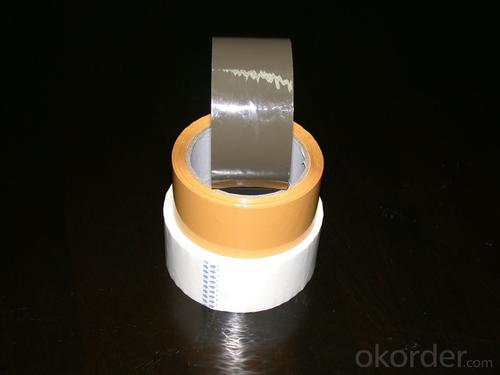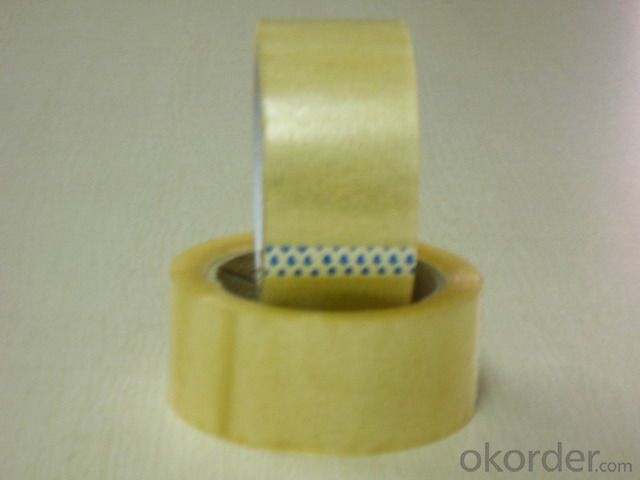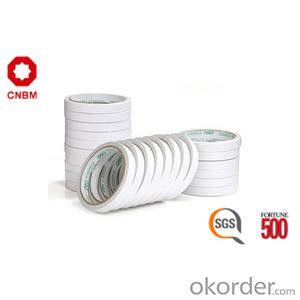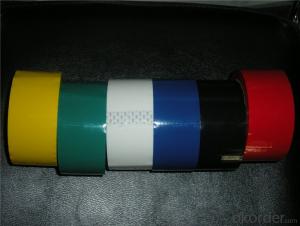Packaging Tape White - Stationery Tape, BOPP Adhesive Tape, Masking Tape
- Loading Port:
- Guangzhou
- Payment Terms:
- TT OR LC
- Min Order Qty:
- 3000 m²
- Supply Capability:
- 10000000 m²/month
OKorder Service Pledge
OKorder Financial Service
You Might Also Like
CONSTRUCTION:
Carrier: BOPP film
Adhesive: Water based acrylic adhesive.
TYPICAL PHYSICAL PROPERTIES:
Total Thickness (adhesives + carrier): 42 ± 1 um
Adhesive thickness:20 ± 1 um
Initial Tack: ³ 23#
180O Peel Adhesion (to steel): ³ 6.52 N /25mm
Holding Power: ³ 31 hrs
PACKING:
Core I.D.: 3” (76mm±1)
Jumbo Roll:1280mm x 4000m
Cut Roll: As per customer’s requirements
Application:
Carton sealing & packing, Light duty packaging, bundling, holding, and other office & household use.
REMARKS:
1. The data above are typical results and subject to change without notice.
2. Tolerance: Weight and Thickness: ±10%; Width: ±3mm;
Length: Cut Roll & Log Roll ±0.3m, Jumbo Roll ±0.5%.
3. The products should be stored at room temperature and be kept away wet and/or heat source.
4. It is essential, as with all pressure-sensitive tapes, that the surface to which the tape is applied must be clean, dry, and free of grease and oil.
5. The users should take test and do trial-application on the above products before coming into application so as to witness and ensure suitability for their special purpose and technique.
TAPE FAQ
What is the range of your products?
So far, we manufacture various kinds of double sided adhesive tape, masking tape, kraft tape and BOPP packing tape. To better meet your needs, we can also source other adhesive tapes for you if it is appropriate to do so.
What's the lead time for delivery?
We ensure you a prompt delivery of the goods. We do not stock any of the goods. The production cycle time of 1*20FCL is 2-3 weeks.
How many carriers does your double sided adhesive tapes have?
There are many carriers that our double sided adhesive tapes based on, which are tissue, PET, BOPP, PE foam, EVA foam.
Can Adhero accept the cooperation way of OEM?
Upon receipt of formal authorization, we can accept OEM processing.
What are the international commodity codes for these products?
HS Code: 48231900.
Are you offering only jumbos rolls or slit rolls as well?
We offer Jumbos, logs, and slit rolls. All different sizes are available.
What are the temperatures resistances of your masking tape?
we have two general kinds of masking tapes separately for general purpose 60°C and high temperature 100°C to 160°C.
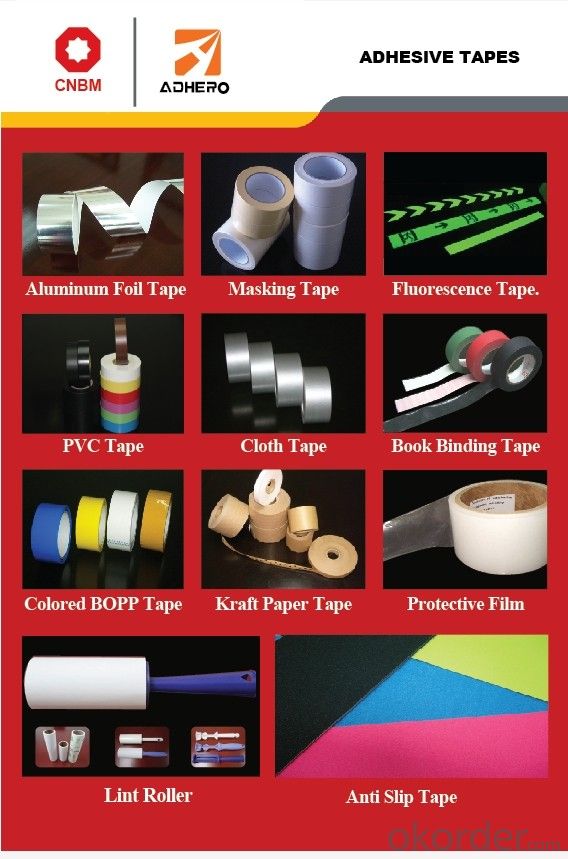

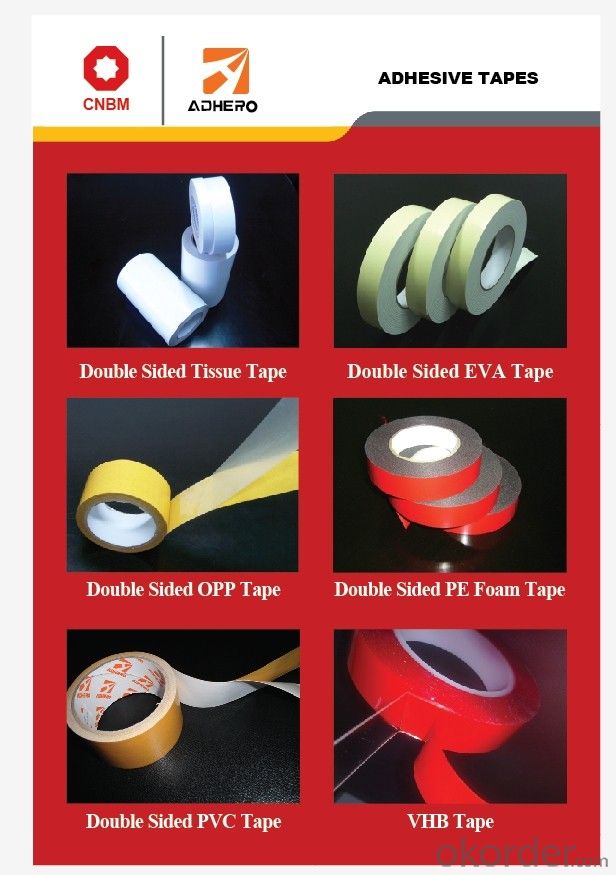
- Q: Can packaging tape be used for mailing packages?
- Yes, packaging tape can be used for mailing packages. It is commonly used to secure and seal packages, ensuring that they remain intact during transit.
- Q: Can packaging tape be used for sealing plastic clamshell packaging?
- Yes, packaging tape can be used for sealing plastic clamshell packaging. Packaging tape is designed to securely seal various types of packaging materials, including plastic clamshell packaging. It provides a strong adhesive bond that holds the clamshell packaging together and prevents it from opening during shipping or handling. Additionally, packaging tape is durable and tear-resistant, ensuring that the clamshell packaging remains sealed and protected throughout the entire distribution process.
- Q: Can packaging tape be used for sealing recreational or outdoor gear?
- Yes, packaging tape can be used for sealing recreational or outdoor gear. Packaging tape is designed to securely seal boxes and packages, providing a strong and durable seal. It can be used to repair tears or holes in gear such as tents, sleeping bags, backpacks, or tarps. Additionally, packaging tape can be used to reinforce weak points or seams in gear, adding extra strength and protection. However, it is important to note that while packaging tape can provide a temporary fix, it may not be as long-lasting or weather-resistant as specialized outdoor repair tapes. It is always recommended to use the appropriate gear repair products for a more reliable and durable solution.
- Q: Does packaging tape come in different lengths?
- Yes, packaging tape does come in different lengths. It is available in various lengths to cater to different packaging needs and requirements.
- Q: Can packaging tape be used for sealing containers with liquids?
- Packaging tape is not suitable for sealing containers with liquids as it is not designed to provide a watertight seal. It may not be able to withstand the pressure or prevent leakage, leading to potential damage or spillage. It is recommended to use appropriate sealing methods such as specialized caps, lids, or seals specifically designed for liquid containers.
- Q: How do I prevent packaging tape from getting tangled?
- To prevent packaging tape from getting tangled, here are a few tips: 1. Use a dispenser: Invest in a tape dispenser specifically designed for packaging tape. The built-in cutting blade and roller mechanism will help keep the tape controlled and prevent tangling. 2. Start with a clean surface: Before applying the tape, ensure the surface is clean and free from dust, debris, or any other potential obstacles that may cause the tape to stick and tangle. 3. Avoid excessive handling: Minimize handling of the tape as much as possible. Each time you touch the tape, there is a higher chance of it twisting or tangling. Try to handle the tape only when necessary. 4. Cut the tape cleanly: Use a sharp cutter or a dispenser with a cutting blade to make clean and straight cuts. Jagged or uneven cuts can cause the tape to twist or tangle as it is being unrolled or applied. 5. Store it properly: When not in use, store the tape in a cool and dry place, away from direct sunlight or extreme temperatures. Keeping the tape in its original packaging or a designated container can also prevent tangling. 6. Unroll carefully: When unrolling the tape, hold the roll firmly and apply a slight tension to keep it straight. Avoid jerky movements or pulling the tape too forcefully, as this can cause it to twist or tangle. By following these tips, you can minimize the chances of packaging tape getting tangled, making your packaging process smoother and more efficient.
- Q: What are the common price ranges for packaging tape?
- The pricing of packaging tape varies based on the type, brand, and quantity of tape you are buying. Basic packaging tape typically costs between $2 and $10 per roll, with lower quality or smaller rolls being cheaper. Mid-range packaging tapes, which may offer better durability or adhesive strength, can be priced from $5 to $20 per roll. Premium or heavy-duty packaging tapes, commonly used for industrial or professional purposes, can range from $10 to $30 per roll. Additionally, you can find bulk packaging tape options that come in packs of multiple rolls, which may have slightly discounted prices. To get the best deal, it is important to consider your specific packaging requirements and compare prices from different suppliers.
- Q: What are the benefits of using transparent packaging tape?
- The benefits of using transparent packaging tape include clear visibility of the contents of the package, easy identification of any tampering or damage, professional appearance, and the tape's durability and strength for securing packages effectively.
- Q: Is packaging tape safe to use on painted surfaces?
- Packaging tape is generally considered safe for use on painted surfaces, but there are a few factors that need to be taken into account. Firstly, it is crucial to make sure that the paint has completely dried before applying any tape. This usually takes about 30 days, depending on the type of paint used. Applying tape to fresh or wet paint can result in damage when the tape is removed. Secondly, the type of tape utilized can also impact the outcome. Most packaging tapes are designed to be easily removable without leaving any residue or causing harm to surfaces. However, there are some low-quality tapes or those with strong adhesives that may leave sticky residue or even strip off the paint upon removal. It is advisable to opt for high-quality packaging tape that is explicitly labeled as safe for painted surfaces. To err on the side of caution, it is always wise to conduct a test on a small and inconspicuous area of the painted surface before applying the tape extensively. This will help ensure that the tape does not cause any damage or leave any residue behind. If there are any concerns, it is recommended to consult the manufacturer's instructions or seek professional advice. In conclusion, when used correctly and on fully dried paint, packaging tape should be safe for use on painted surfaces. However, it is vital to exercise caution and select the appropriate tape to prevent any potential damage.
- Q: How does packaging tape perform on low-friction surfaces?
- Packaging tape generally does not perform well on low-friction surfaces. Low-friction surfaces, like smooth plastics or certain types of laminates, lack texture and adhesion, making it challenging for packaging tape to effectively stick and hold. The lack of friction allows the tape to easily slide or peel off the surface, compromising the integrity of the package. In such cases, it is advisable to use alternative methods like shrink wrapping, heat sealing, or adhesive sprays specifically designed for low-friction surfaces. These alternatives provide better adhesion and ensure the package remains securely sealed during handling and transportation.
Send your message to us
Packaging Tape White - Stationery Tape, BOPP Adhesive Tape, Masking Tape
- Loading Port:
- Guangzhou
- Payment Terms:
- TT OR LC
- Min Order Qty:
- 3000 m²
- Supply Capability:
- 10000000 m²/month
OKorder Service Pledge
OKorder Financial Service
Similar products
Hot products
Hot Searches
Related keywords





